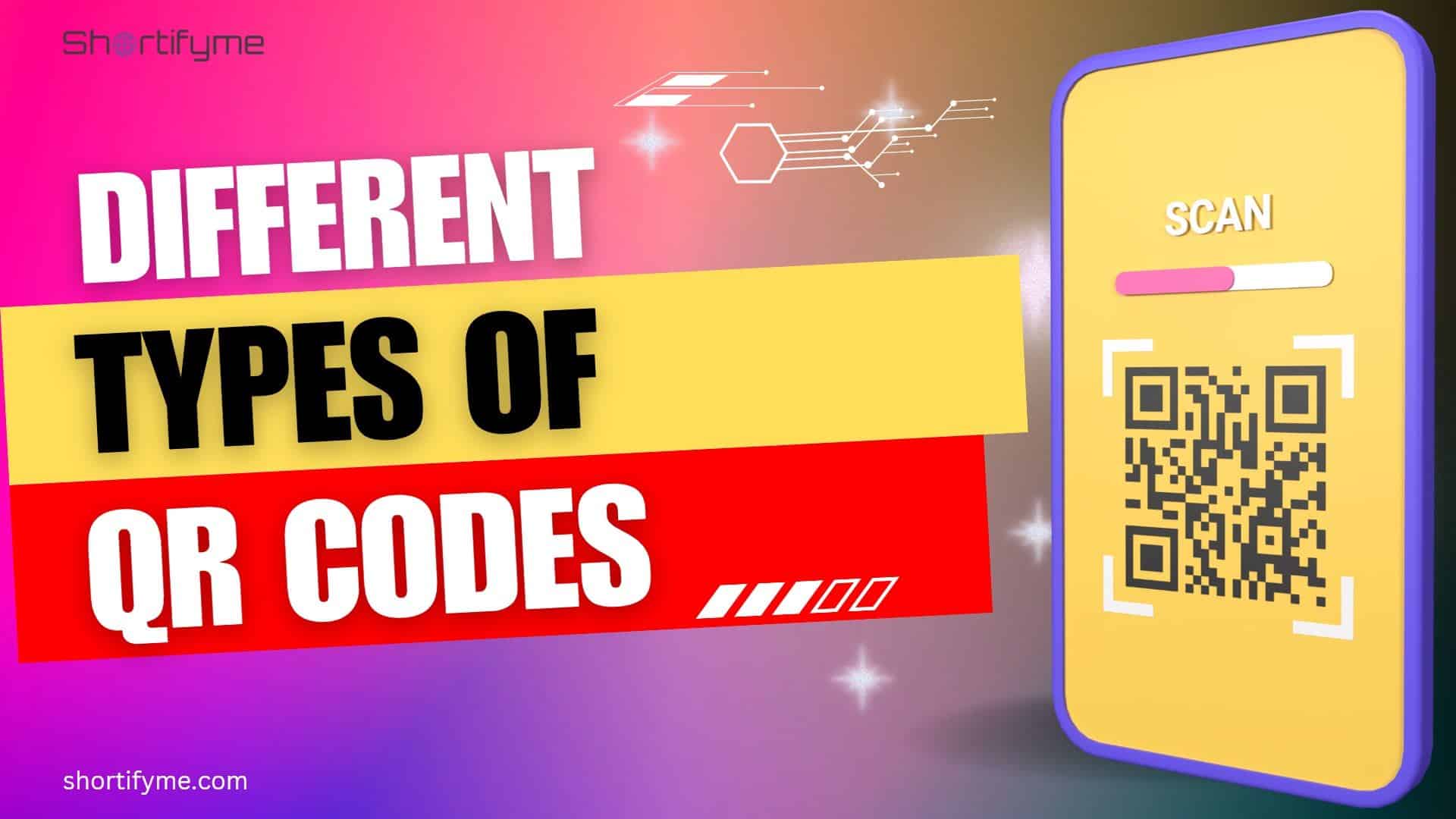Quick Introduction
In technology, Quick Response (QR) codes have emerged as a versatile and powerful tool, steadily gaining popularity.
These pixelated patterns hold a myriad of possibilities, bridging the physical and digital worlds seamlessly.
From restaurant menus to magazine pages, bus stops to billboards, these ingenious squares are popping up everywhere, offering seamless connections and instant access to a wealth of information.
But just like snowflakes, no two QR codes are exactly alike.
This unassuming square holds within its depths a spectrum of functionalities, each type tailored to a specific purpose.
So, dive in with me as we embark on a quest to decode the mysteries of these fascinating digital gateways!
What is a QR Code?

A QR code, short for “Quick Response Code,” is a two-dimensional barcode that stores information in a machine-readable format.
Imagine it as a digital portal, capable of instantly linking users to a wealth of information with a simple scan.
It’s like whispering a secret in binary, only a smartphone equipped with the right decoder ring can crack the code.
Types of QR Codes: Static vs Dynamic QR Codes

The world of QR codes isn’t a monolithic one. Just like humans, they come in different flavors, each with its strengths and quirks.
The two main tribes are Static and Dynamic QR codes, each catering to distinct needs.
Static QR Codes
Think of them as the stoic philosophers of the QR world. Once created, their encoded information remains set in stone, unchangeable like a carved inscription.
Perfect for directing users to websites, showcasing contact details, or sharing Wi-Fi credentials, static codes offer a simple, no-frills solution.
How Static QR Codes Work?
Static codes store information directly within the code itself, making them simple and quick to generate. However, any changes in the linked data require the creation of a new code.
Features:
- Fixed Data:
Static QR codes have unchanging, fixed data encoded within them.
- Simplicity:
Once generated, the information in static QR codes remains constant, making them straightforward to create and deploy.
- Offline Accessibility:
Static QR codes do not depend on a live internet connection for access, ensuring reliable functionality even in offline environments.
Benefits:
- Ease of Creation:
Static QR codes are quick and easy to generate, making them suitable for scenarios where the information to be shared remains relatively constant.
- Stability:
The stability of the encoded data makes static QR codes reliable for situations where the information doesn’t need frequent updates.
- No Dependency on Internet:
Static QR codes are ideal for environments with limited or no internet access, as the information is self-contained within the code.
Dynamic QR Codes
These are the chameleons of the bunch, constantly evolving and adapting. The information they encode can be updated on the fly, even after they’ve been printed or deployed.
Imagine having a menu that morphs with seasonal specials, or a business card that automatically reflects your latest job title!
Dynamic codes offer unparalleled flexibility and real-time data tracking, making them ideal for marketing campaigns, product packaging, and dynamic content delivery.
Features:
- Editable Content:
Dynamic QR codes allow real-time modification of the encoded information, offering flexibility for changing data.
- Tracking and Analytics:
Dynamic QR codes often come with tracking capabilities, providing insights into user interactions, scan counts, and other analytics.
- Enhanced Security:
Dynamic QR codes may offer security features such as password protection and expiration dates for added control over access.
Benefits:
- Flexibility:
Dynamic QR codes are suitable for scenarios where the encoded data needs to be updated regularly, such as event details or changing promotions.
- Marketing Insights:
The tracking and analytics features provide valuable data for marketing analysis, allowing users to understand user behavior and the effectiveness of campaigns.
- Security Measures:
Enhanced security features, like password protection and expiration dates, help safeguard sensitive information and manage the lifespan of promotions.
Different Types of QR Codes
But the diversity doesn’t stop there! Just like snowflakes, each QR code type caters to a specific niche. Let’s dive into some of the most popular varieties:
Model 1 and Model 2 QR Codes

Model 1 QR codes are the original, with a grid size of 21×21 modules. Model 2, an evolution, provides increased data capacity with a grid size of 25×25 modules. Both share a common principle of storing information in a matrix pattern.
Model 1 QR codes were the initial version introduced by Denso Wave (the inventors of QR codes). These codes have a maximum capacity of 7,089 numeric characters.
Model 2 QR codes are an enhanced version with increased data capacity. This model is widely used and has become the standard for QR codes in various applications.
Features:
- Model 1:
-
- Standard 21×21 grid.
- Efficient for small data sets.
- Primarily used for simple applications.
- Model 2:
-
- Larger 25×25 grid.
- Increased data capacity.
- Widely adopted for diverse purposes, including marketing, logistics, and more.
Benefits:
- Model 1:
-
- Compact and quick to scan.
- Suitable for basic data storage.
- Model 2:
-
- Ideal for larger data sets.
- Enhanced error correction.
Micro QR Code

Designed for applications with limited space, the Micro QR code offers a compact solution without compromising data capacity. Micro QR codes are a smaller version of standard QR codes.
Think of it as the miniature marvel of the QR world. This tiny titan packs a punch, able to encode information in incredibly small spaces, perfect for product labeling or delicate surfaces.
Features:
- Smaller grid size.
- Efficient for constrained spaces.
- Suitable for applications with limited space or requiring higher data density.
Benefits:
- Perfect for small product labels.
- Retains data integrity in limited print areas.
- Commonly used in electronics, healthcare, and mobile applications.
rMQR Code

The Rectangular Micro QR code (RMQR) optimizes data storage for rectangular spaces, catering to scenarios where a square layout isn’t practical.
It is an extension of the Micro QR Code that allows for a rectangular shape, providing flexibility in design and application.
This code boasts resilience, a knight in shining armor protecting your data from wear and tear. Ideal for harsh environments or long-lasting applications, rMQRs ensure your message endures.
Features:
- Rectangular matrix layout.
- Efficient data storage for non-square spaces.
- Compact size suitable for constrained spaces.
Benefits:
- Versatile application in diverse print layouts.
- Ideal for packaging with limited square surfaces.
- Offers a balance between data capacity and space efficiency.
SQRC

SQRC, or Secure QR Code, is a type of QR code developed by DENSO WAVE. SQRC brings a balance between traditional QR codes and the compactness of Micro QR codes, providing versatility in design and application.
Imagine a QR code that whispers sweet nothings to your smartphone. SQRC codes enable secure communication between devices, opening doors, sharing Wi-Fi credentials, and more, all with a single scan.
Features:
- Square matrix layout.
- Enhanced design flexibility.
- It incorporates security features, making it suitable for applications where data integrity and authenticity are crucial.
Benefits:
- Maintains scan ability while accommodating design preferences.
- Suitable for various marketing materials.
- Applications include secure transactions, access control, and authentication.
Frame QR Code

Combining utility with aesthetics, the Frame QR code integrates a QR code within a decorative frame, blending functionality and visual appeal.
Think of it as a QR code with a flair for the dramatic. This flashy variant incorporates decorative elements around the code itself, adding a touch of visual pizzazz to your marketing campaigns.
Features:
- QR code embedded in a frame.
- Customizable frame designs.
- Combines functionality with aesthetic appeal.
Benefits:
- Merges functionality with branding.
- Ideal for promotional materials.
- Used for branding purposes and to enhance the visual appeal of the QR code.
QR Code vs Barcode: What’s the Difference?
While both QR codes and barcodes serve the purpose of encoding information, QR codes have a distinct edge. They can store more data types, including URLs, making them more versatile than traditional barcodes.
Barcodes

- One-Dimensional: Think of them as simple lines of varying thickness, representing numerical data.
- Limited Information: Can only store a few digits, typically used for product identification and tracking.
- Line-of-Sight Scanning: Requires a direct line of sight between the scanner and the code.
- Limited Interactivity: Primarily used for internal purposes, with minimal user engagement.
QR Codes

- Two-Dimensional: A grid of black and white squares, encoding alphanumeric data, URLs, and even images.
- High Information Capacity: Can hold hundreds or even thousands of characters, offering greater flexibility.
- Omnidirectional Scanning: Can be scanned from any angle, making them more user-friendly.
- High Interactivity: Can direct users to websites, social media profiles, or launch actions like adding contacts or connecting to Wi-Fi.
Types of 2D Barcodes
Before we crown QR codes the undisputed king of 2D barcodes, let’s acknowledge the other contenders in the arena:
Data Matrix

Similar to QR codes, but with a square bullseye pattern in the center. Offers high data density and error correction. Compact and versatile for encoding small amounts of data.
Characteristics:
- Compact design.
- Versatile for encoding small amounts of data.
- Efficient in industrial and manufacturing environments.
MaxiCode

A high-capacity code is often used for postal applications and tracking packages. High-capacity code is primarily used for logistics and shipping.
Characteristics:
- High-capacity code.
- Primarily used for logistics, shipping, and package tracking.
- Hexagonal design with central bulls-eye.
DotCode

DotCode is designed for high-speed industrial printing applications. It is optimized for fast printing processes, making it suitable for various manufacturing and production environments.
Characteristics:
- Specifically designed for industrial printing.
- High-speed scanning capabilities.
PDF417 Code

PDF417 can store large amounts of data in both text and binary formats. It is widely used for applications that require encoding substantial information.
Characteristics:
- Stores large amounts of data.
- Supports both text and binary data formats.
- Commonly used in ID cards and transportation applications.
Han Xin

Aztec Code is a compact and versatile 2D barcode suitable for various applications. It is known for its high data capacity and flexibility.
Characteristics:
- Compact design.
- Versatile application.
- Suitable for encoding a variety of data types.
Benefits of Using QR Codes
Increased Engagement and Interactivity
QR codes foster direct engagement, bridging the gap between the physical and digital realms.
Users can seamlessly access information, promotions, or interactive content with a simple scan.
Improved Customer Experience and Convenience
Say goodbye to tedious manual data entry! Enhance user experience by providing quick access to relevant information, discounts, or multimedia content.
QR codes simplify processes and make information readily available.
Cost-effective Marketing and Advertising Tool
QR codes eliminate the need for extensive print materials by digitally linking to dynamic content.
QR codes are surprisingly versatile marketing tools, allowing you to track campaign effectiveness, personalize customer experiences, and collect valuable data.
This not only saves costs but also allows for real-time campaign adjustments.
Data Tracking and Analytics Capabilities
Dynamic QR codes enable businesses to track user interactions, providing valuable data for marketing strategies.
Embedded in QR codes lies the potential to track scans, user demographics, and engagement metrics, providing valuable insights for businesses and marketers.
Analyzing scan data helps in understanding customer behavior and optimizing campaigns.
Paperless and Eco-friendly Solution
Reducing the reliance on physical materials, QR codes contribute to a paperless environment.
They align with eco-friendly practices, making them a sustainable choice for businesses.
QR codes eliminate the need for printed flyers or brochures, reducing paper waste and promoting sustainability.
⇒ Unlock the Full Potential of QR Codes with ShortifyMe!
Why do Businesses Marketers Choose QR Codes Over Other Barcodes?
The answer lies in their inherent versatility and user-centric design.
QR codes offer a seamless bridge between the physical and digital worlds, engaging users, providing valuable data, and enhancing customer experiences in ways that traditional barcodes simply cannot.
They’re the digital Rosetta Stone, unlocking a wealth of possibilities for businesses and individuals alike.
Marketers can deliver dynamic content, track user interactions, and streamline campaigns with ease.
Conclusion
The world of QR codes is a fascinating one, brimming with potential and constantly evolving. As we navigate this digital landscape, understanding the different types of QR codes and their unique strengths becomes increasingly important.
Whether you’re a business owner seeking to engage customers, a marketer crafting interactive campaigns, or simply a curious individual exploring the possibilities of technology, QR codes offer a powerful tool to connect, inform, and unlock a world of possibilities.
So, the next time you encounter that enigmatic square, don’t hesitate to reach for your smartphone and crack the code. The hidden treasures within might just surprise you!



